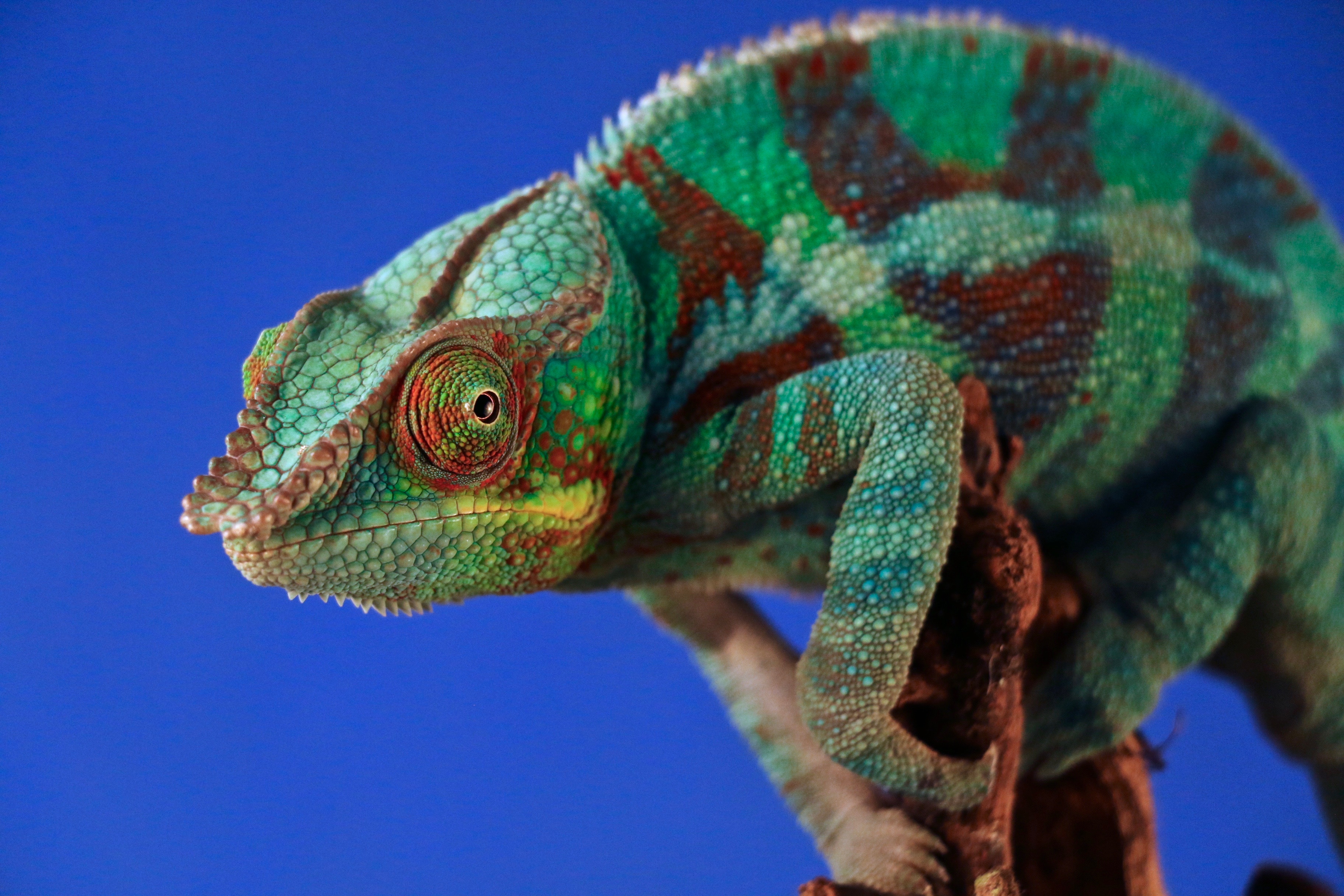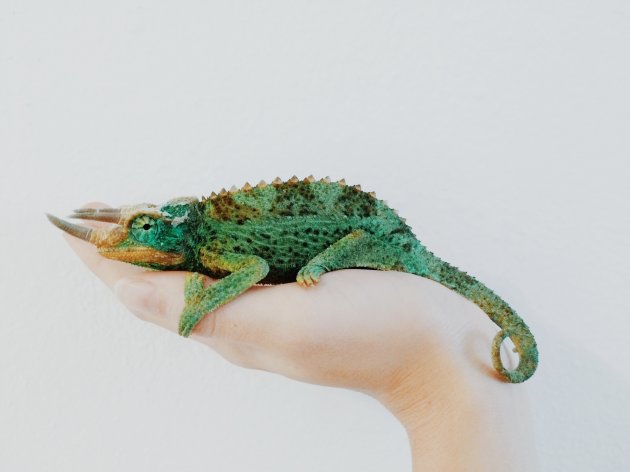Chameleons are a type of old-world lizards. Their colors vary widely according to their habitat and they possess the ability to change colors. As the chameleon skin is made up of four different layers namely epidermis, chromatophore, melanophore, and nether layers, and these layers contain different color pigments in their cells; different color patterns are manifested when these layers contract or expand in the events of being frightened by something like light and temperature or emotions associated during or after a tussle with another chameleon. Their prominent features are zygodactylous feet which account for the toes of each foot to be fused together in groups of two and three alternately in the fore and hind feet for getting a better grasp of the tree branches, long folded and sticky projectile tongue to catch prey from a distance, and a pair of independently rotating eyes which adds to their alertness but are focused in unison while catching their prey.
They mostly live in the tropical rainforests, African deserts, South Asian plateau, and Southern Europe's savannah, but they are preferred by many as pets and they are found in household confines in many parts of the world.

PROS:
They are adorable: They look pretty beautiful and the fact that they can change colors have made them cuter.
They are low-energy pets: Chameleons are slow-moving, and low-energy animals that do not require much attention to be happy. They usually live happily within their habitat made up of plants and branches which they can climb on, provided the type of food they prefer is also kept in the cage. Some people prefer them as a pet because they have more time for their usual activities. Only once their cage or terrarium is set up properly along the necessary guidelines and after that, it is only to be monitored so that the supplies are properly maintained.
They live longer: Chameleons generally live in the wild for only 2 to 3 years. But if proper care is taken by the owners, they can live up to 10 years which is quite a long time for a pet to stay around.
They weigh less: The weight of a chameleon differs from species to species. It also differs according to the age and health of the lizard. The weight of a male veiled chameleon varies from 85 grams to 170 grams, whereas that of a female veiled chameleon hovers between 85 grams and 118 grams.
Silent creatures when left alone: The chameleons are very calm creatures. If they are provided proper nourishment and a habitat similar to theirs where they used to live, they will remain sensibly cheerful and will not trouble you by any stretch of the imagination.
They are affectionate: They are affectionate in the sense that they need proper care with regards to the habitat and food that they are used to, and as long as these two things are provided properly, they will not mind your companionship and will not bite you.

CONS:
Body Odor: Chameleons do not possess any odor as such but smell like rotten meat when they wipe their jaws against tree branches exuding a foul-smelling, waxy material to attract prey. Moreover, the chameleons excrete white colored poop which smells like human urine to some extent.
Health Issues: Much care is to be taken to ensure that the habitat of the chameleon is perfectly maintained. Still, a number of health issues can come up like Edema, Injuries, Respiratory Infection, Shedding, Mouth Infection, Tongue Retraction Problem, and Egg Binding.
Temperature Adaptability: Different types of chameleons prefer different temperature ranges. So proper care has to be taken to check with a thermometer that the temperature is within the range. Otherwise, a little sprinkling of water has to be done or some more basking bulbs are to be lit. Generally, the temperature range that most of the chameleons can bear is 50 degrees Fahrenheit to 70 degrees Fahrenheit.
Diet Needs: Chameleons are insectivorous lizards. Insects like crickets, mealworms, wax worms, and superworms are to be gut loaded first with nutritious food, and then they are to be fed to the chameleon. Pinkie mouse, a newborn mouse, can be fed to a large chameleon pet. Plants like mustard, collard, romaine lettuce, kale, turnip, and dandelion greens can be chopped to smaller sizes and provided. Reptile supplements like Calcium with Vitamin D3 and Multivitamins are available in the form of powder, which is to be sprinkled in optimum amounts on the food to prevent Vitamin A, Calcium and Vitamin D3 deficiencies. Water has to be provided through a mister or a dripper or a spray bottle very slowly so that droplets form on the leaves where from the chameleon can drink water.
Special Lighted Environment: The chameleons are very calm creatures. If they are provided proper nourishment and habitat similar to theirs where they used to live, they will remain sensibly cheerful and will not trouble you by any stretch of the imagination.
Price: The cost of a chameleon varies from species to species. The cost of a pet veiled chameleon in the US market varies from $30 to $100 depending on the age and health of the lizard. But the cost of creating its habitat and maintaining it is pretty high.
It is true that each of us might have our own perspective when deciding whether to adopt a chameleon as a pet. This article has tried to weigh out both sides of the coin based on public opinion and logical importance. Check out which you can relate to most and accordingly make your decision.
Sources and further readings:
- ChameleonForums,Do Chameleons have the ability to show affection to their owners?
- petMD, Veiled Chameleon
- SanDiegoZoo, Chameleon
- National Geographic, Chameleon Animal Profile
- Francois Le Berre, 2009, Chameleon Handbook (book)